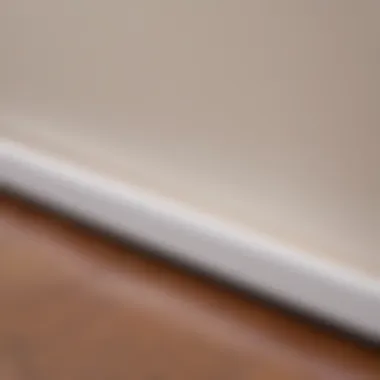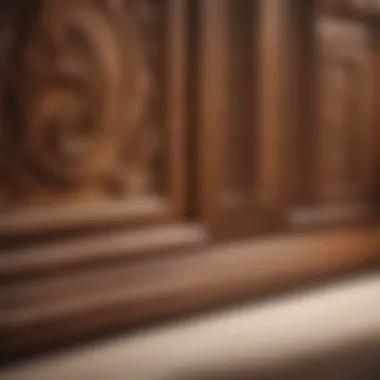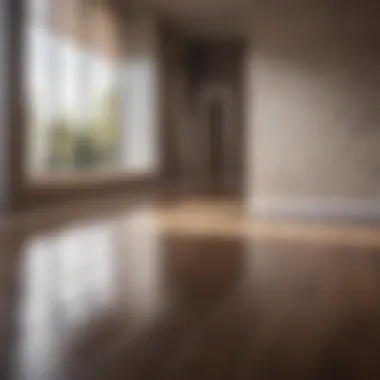Materials:
- Pre-primed MDF molding: 100 linear feet
- Paint (color of choice): 1 gallon
- Caulk and caulk gun: 1 tube
- Sandpaper (fine grit): 1 pack
DIY Steps:
- Measure the perimeter of the room where the molding will be installed.
- Purchase the necessary materials as listed above.
- Cut the molding to the measured lengths using a miter saw.
- Sand down any rough edges for a smooth finish.
- Prime and paint the molding to desired color and finish.
- Apply a bead of caulk along the backside of the molding to adhere to the wall.
- Secure the molding in place using finishing nails.
Technical Aspects:
- Tools needed: Miter saw, caulk gun, hammer, level
- Timing specifics: Allow time for drying between coats of paint
- Critical techniques: Ensure precise measurements for a seamless finish
DIY Project Process:


- Start by measuring and cutting the molding to fit the room's dimensions accurately.
- Sand the edges to ensure a smooth finish.
- Prime and paint the molding, allowing for adequate drying time between coats.
- Apply caulk along the back to prevent gaps between the wall and molding.
- Secure the molding in place with finishing nails, ensuring it is level and properly aligned.
Troubleshooting Tips:


- If gaps occur, use additional caulk to fill in the spaces.
- In case of uneven installation, gently adjust the molding before it sets in place.
- Ensure all measurements are precise to avoid slips or misalignments.
Introduction


Defining Floor Molding
Floor molding, also known as baseboard molding, refers to the decorative trim that runs along the base of interior walls where they meet the floor. It serves both aesthetic and functional purposes, covering the inevitable gaps between the wall and the floor while adding a stylish touch to the room.
Significance of Floor Molding
The importance of floor molding extends beyond its visual appeal. It acts as a protective barrier, safeguarding walls from furniture scuffs, vacuum marks, and other potential nicks and dents. Additionally, floor molding can conceal imperfections or inconsistencies in flooring installations, providing a seamless transition between different surfaces. Moreover, floor molding ties together the overall design scheme of a room, creating a cohesive look that enhances the architectural character and elevates the space's ambiance.
Types of Floor Molding
Floor molding is a crucial aspect of interior design, not only adding visual appeal but also serving practical purposes in protecting walls and floors. In this article, the discussion of the types of floor molding is essential as it provides readers with insights into the various options available to enhance their living spaces. By examining the different types of floor molding, including baseboard molding, crown molding, and quarter round molding, individuals can make informed decisions based on their preferences and requirements.
Baseboard Molding
Materials Used
When it comes to baseboard molding, the choice of materials used plays a significant role in determining the overall look and durability of the molding. Common materials for baseboard molding include wood, MDF, PVC, and plaster. Wood is a popular choice due to its classic appearance and ease of customization. MDF is a cost-effective alternative known for its smooth finish and paintability. PVC is preferred for its moisture resistance, making it suitable for areas prone to moisture exposure. Plaster baseboards offer intricate designs for a more luxurious look. Each material has its advantages and considerations, such as cost, maintenance, and compatibility with different decor styles.
Styles Available
Discussing the styles available for baseboard molding is essential as it allows homeowners to choose designs that complement their interior aesthetics. Some popular styles of baseboard molding include traditional, modern, craftsman, and colonial. Traditional baseboards feature simple, straight profiles that work well in classic settings, while modern styles offer clean lines and minimalist designs suitable for contemporary spaces. Craftsman baseboards showcase detailed woodwork that adds character to a room, ideal for rustic or arts and crafts-inspired interiors. Colonial baseboards exhibit historical charm with intricate detailing, perfect for traditional or vintage-themed decor. Understanding the unique characteristics of each style helps individuals select baseboard molding that aligns with their design preferences.
Crown Molding
Material Options
The material options available for crown molding influence both the aesthetic appeal and longevity of this refined architectural feature. Common materials for crown molding include polyurethane, wood, plaster, and MDF. Polyurethane crown molding is lightweight, easy to install, and resistant to moisture and insects, making it a practical choice for various rooms. Wood crown molding exudes luxury and warmth, enhancing the elegance of formal spaces such as living rooms and dining areas. Plaster crown molding offers intricate detailing and historical authenticity, ideal for restoration projects or period-style homes. MDF crown molding combines affordability with versatility, allowing for intricate designs and straightforward installation, suitable for budget-conscious renovations.
Design Varieties
Exploring the design varieties of crown molding enables individuals to select profiles that complement their home's architectural style and decor themes. Some popular design options for crown molding include dentil, cove, egg and dart, and rope. Dentil crown molding features rectangular blocks resembling teeth for a classic, ornate look that works well in traditional interiors. Cove crown molding has a concave curve that creates a soft transition between walls and ceilings, contributing to a seamless and elegant finish in contemporary spaces. Egg and dart crown molding showcases an intricate motif of alternating eggs and darts along the profile, adding sophistication and visual interest to formal rooms. Rope crown molding mimics twisted rope for a textured, luxurious accent that suits grand or upscale settings. By understanding the design elements of crown molding, homeowners can enhance the aesthetic value of their living spaces with tailored and timeless solutions.
Quarter Round Molding
Cost Factors
The cost of quarter round molding is influenced by factors such as the material chosen, the length of the molding required, and any additional preparations needed for installation. Materials commonly used for quarter round molding include wood, PVC, and composite. Wood quarter round molding offers a traditional appearance and can be stained or painted to match existing trim for a cohesive look. PVC quarter round molding is moisture-resistant, making it ideal for bathrooms, kitchens, or basements where water exposure is a concern. Composite quarter round molding combines wood fibers and plastic for a durable, low-maintenance option that is easy to install. Considering the cost factors helps individuals budget effectively for their quarter round molding project while balancing quality, aesthetics, and practicality.
Installation Techniques
Understanding the installation techniques for quarter round molding is essential for achieving professional and seamless results. Common installation methods include using finish nails, adhesive, or a combination of both to secure the molding in place. Before installation, it is crucial to measure and cut the quarter round molding accurately to fit corners and transitions smoothly. Properly sealing joints and finishing the molding with caulk or putty enhances the visual appeal and durability of the installation. Each technique has its advantages and considerations in terms of ease of application, stability, and finishing options, allowing individuals to choose the most suitable method based on their skills and project requirements.
Factors Influencing Cost
In the realm of floor molding, the factors influencing cost play a pivotal role in determining the overall expenses involved in a molding project. Understanding these factors is essential for anyone embarking on such a project, as it shapes budgeting decisions and overall outcome quality. Material selection, molding style, and labor costs stand out as primary components that directly impact the final cost of the molding installation. By carefully considering each of these elements, individuals can make informed choices aligning with their budget and aesthetic preferences. Material Selection
When it comes to floor molding, material selection is a critical aspect that significantly affects the overall cost of the project. Various materials such as wood, MDF, PVC, or composite materials come with different price points, durability levels, and aesthetic appeals. Factors like the material's quality, availability, and finish contribute to its pricing. High-end materials will naturally cost more, while opting for more affordable options can help reduce expenses without compromising on quality. Molding Style
The molding style chosen for a project also plays a crucial role in determining the overall cost. Different molding styles, such as baseboard, crown, or quarter round molding, come with varying complexities and material requirements. Intricate designs and customized profiles typically incur higher costs compared to simpler, standard profiles. Individuals looking to achieve a specific look or design aesthetic should be prepared for potential additional expenses when opting for bespoke molding styles. Labour Costs
Labor costs represent a significant portion of the overall expenses of a floor molding project. Hiring professional installers or undertaking the installation independently factors into the total cost calculation. Professional installation guarantees precision and efficiency but comes at a higher price, considering the expertise and labor involved. On the other hand, DIY installation can reduce labor costs but requires adequate skills and time commitment. Understanding the trade-offs between professional labor and DIY approaches is crucial for assessing the cost implications accurately.
Cost Estimation
Average Price Ranges
For Different Materials
When considering the average price ranges for different materials used in floor molding, it is essential to analyze the cost implications carefully. Materials such as wood, MDF, PVC, and foam offer varying price points, each with its unique characteristics and benefits. Wood, known for its classic and versatile nature, generally falls on the higher end of the price spectrum due to its durability and aesthetic appeal. On the other hand, PVC and foam molding are more budget-friendly options, ideal for cost-conscious individuals looking to achieve a similar look at a lower price point. Understanding the price variations among different materials enables homeowners to make informed decisions based on their budget constraints and desired aesthetics.
Based on Style Complexity
The complexity of molding styles directly influences the overall cost estimation for a project. Intricate and elaborate designs require more intricate manufacturing processes and skilled labor, leading to higher pricing. Conversely, simpler and more straightforward styles are often more cost-effective to produce and install. Factors such as ornate details, custom finishes, and intricate patterns contribute to the complexity of the molding style and subsequently impact the overall pricing. By evaluating the impact of style complexity on cost estimation, homeowners can align their design preferences with their budgetary considerations effectively.
Additional Expenses
Installation Costs
Installation costs play a significant role in the overall budgeting for floor molding projects. Hiring professional installers or opting for a DIY approach each carries its own cost implications. Professional installation services ensure precision and expertise but come at a higher price point due to labor charges. On the other hand, DIY installations might seem cost-effective initially, but homeowners should consider the time, effort, and potential rework expenses that could arise from inexperienced installations. Understanding the trade-offs between professional installation costs and DIY approaches is essential in determining the most cost-effective solution for each individual project.
Finishing Touches
Finishing touches, although often overlooked, contribute to the final cost of a molding project significantly. Details such as caulking, painting, and additional decorative elements enhance the overall aesthetic appeal of the molding but also incur additional expenses. Homeowners should factor in these finishing touches when budgeting for their project to achieve a polished and cohesive look. While these additions may increase the overall cost, they play a pivotal role in elevating the visual impact of the molding and adding a professional touch to the final installation.
Installation Process
The Installation Process plays a crucial role in the overall outcome of a floor molding project. It is imperative to understand the significance of a well-executed installation to ensure the durability, functionality, and aesthetic appeal of the molding.
Throughout this article, we emphasize the importance of attention to detail during the installation process, as this step can make a substantial difference in the final result. An adept installation not only enhances the visual impact of the molding but also contributes to its structural integrity, ensuring longevity.
When delving into the installation process, it is essential to consider factors such as precision cutting, proper alignment, and secure attachment to the walls or floors. The quality of installation directly impacts the seamless integration of molding with the existing decor and architecture, elevating the overall design of the space.
Moreover, understanding the nuances of installation techniques for different types of molding, whether baseboard, crown, or quarter round, allows homeowners to make informed decisions based on their specific requirements and preferences.
DIY vs. Professional Installation
Deciding between DIY and professional installation is a crucial consideration that directly influences the success of a floor molding project. Each option has its unique advantages and drawbacks, which homeowners should carefully weigh before making a choice.
Opting for a DIY installation can offer cost savings and a sense of accomplishment for individuals adept at home improvement projects. However, it requires a certain level of skill, precision, and patience to achieve professional-looking results. DIY enthusiasts must be willing to invest time and effort into mastering installation techniques and handling any unforeseen challenges that may arise.
On the other hand, professional installation guarantees expertise, convenience, and a polished finish. Hiring skilled professionals ensures a swift and efficient installation process, minimizing potential errors and ensuring precise execution. While professional services come at an additional cost, the peace of mind and quality assurance they provide can justify the investment for many homeowners.
Preparation Steps
Before initiating the installation of floor molding, thorough preparation is key to a successful outcome. Preparation steps encompass a range of essential tasks that pave the way for a smooth and seamless installation process.
Firstly, assessing the space and measuring accurately to determine the required length of molding is paramount. Proper measurements prevent wastage of materials and ensure a precise fit, enhancing the overall aesthetic appeal of the molding. Additionally, preparing the walls by cleaning, priming, and addressing any imperfections contributes to a flawless finish and enhances adhesion.
Furthermore, organizing the necessary tools and materials, such as a miter saw, level, nail gun, and adhesives, streamlines the installation process and minimizes interruptions. Adequate preparation sets the foundation for a successful installation, enabling homeowners to proceed with confidence and efficiency.
Common Challenges
Despite meticulous planning and preparation, floor molding installation can present various challenges that homeowners may encounter during the process. Being aware of these common challenges and how to address them proactively is essential for a smooth and successful installation.
One prevalent challenge is achieving tight and seamless corners, especially with intricate molding profiles. Proper mitering and angling are crucial to ensure a seamless transition between adjoining pieces of molding, maintaining a cohesive look throughout the installation.
Additionally, overcoming issues related to uneven walls or floors can pose a significant challenge during installation. Addressing irregularities in the surfaces with shimming, sanding, or leveling compounds is vital to achieving a flush and uniform installation.
Moreover, handling transitions between different types of molding or integrating molding with existing architectural features requires attention to detail and precision. Ensuring continuity in design and alignment across various molding elements contributes to a cohesive and harmonious aesthetic within the space.
Conclusion
In this article exploring the costs of floor molding, the Conclusion section serves as a pivotal point encapsulating the essential aspects discussed throughout the piece. Understanding the cost implications of floor molding is vital for any homeowner or housewife embarking on a remodeling project. The Conclusion segment brings together the diverse factors affecting the pricing dynamics of floor molding, providing a holistic view for individuals planning such endeavors. It consolidates insights on material selection, molding styles, and labor costs to offer a well-rounded perspective on budgeting effectively for molding projects.
Delving deeper, the Conclusion underlines the significance of thorough research and planning when it comes to estimating costs for floor molding. By highlighting the average price ranges for different materials and style complexities, readers can make informed decisions aligning with their budgetary constraints. Moreover, the Conclusion section sheds light on the additional expenses associated with installation and finishing touches. This comprehensive guide aims to equip readers with the knowledge necessary for navigating the intricacies of floor molding costs.
Transitioning from the preparatory phases to the fruition of the molding project, the Conclusion emphasizes the importance of foresight and meticulous budgeting. It underscores the benefits of careful consideration in material and style selection to achieve the desired outcome within the anticipated financial scope. By fostering an understanding of the various cost components and estimation techniques, the Conclusion empowers readers to approach their floor molding projects pragmatically and resourcefully.
In essence, the Conclusion section acts as a compass, directing readers towards a well-informed and financially savvy approach to floor molding projects. It consolidates the key takeaways and considerations elucidated in the preceding sections, serving as a roadmap for achieving cost-effective and aesthetically pleasing results. By synthesizing intricate cost factors and budgeting strategies, the Conclusion ensures that readers are well-equipped to embark on their flooring journey with confidence and clarity.





